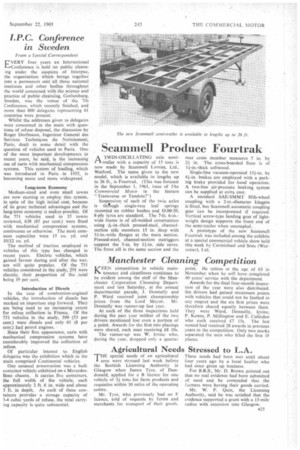.P.C. Conference in Sweden
Page 59

If you've noticed an error in this article please click here to report it so we can fix it.
From a Special ,Correspondent
EVERY four years an International Conference is held on public cleansing under the auspices of Intel-pile, the organization which brings together into a permanent unit all those national institutes and other bodies throughout the world concerned with the science and practice of public cleansing. Gothenburg, Sweden, was the venue of the 7th Conference, which recently finished, and more than 800 delegates representing 41 countries were present.
Whilst the addresses given to delegates were concerned in the main with questions of refuse disposal, the discussion by Roger Dorfmann, Ingenieur General des Services Techniques du Nettoiement, Paris, dealt in some detail with the question of vehicles used in Paris. One of the Most important developments in recent years, he said, is the increasing use of carts with mechanical compression systems. This system of loading, which was introduced in Paris in 1935, is becoming more and more widespread.
Long-term Economy Medium-sized and even small towns are now starting to employ this system, in spite of the high initial cost, because of its great technical advantages and the long-term economy it makes possible. Of the 751 vehicles used in 35 towns reviewed, 638 (85 per cent.) were fitted with mechanical compression systems, continuous or otherwise. The most common capacities were 15 cu. yd. and 10/12 cu. yd.
The method of traction employed in vehicles of this type has changed in recent years. Electric vehicles, •which gained favour during and after the war. are still quite popular. Of the 751 vehicles considered in the study, 291 were electric, their proportion of the total being 39 per cent.
Introduction of Diesels In the case of combustion-engined vehicles, the introduction of diesels has marked an important step forward. They are being used to an increasing extent for refuse collection in France. Of the 751 vehicles in the study, 399 (53 per cent.) were diesels and only 61 (8 per cent.) had petrol engines.
Since their first appearance, carts with mechanical compression systems have considerably improved the collection of refuse. . • Of particular interest to English delegates was the exhibition which in the main comprised Continental vehicles.
One unusual presentation was a bulk container vehicle exhibited on a MercedesBenz chassis. It carries five containers, the full width of the vehicle, each approximately 2, ft. 6 in. wide and about 3 ft. in depth. As each of these containers provides a storage capacity of 3-4 cubic yards of refuse, the total carrying capacity is quite substantial.




































































































































